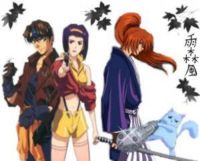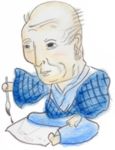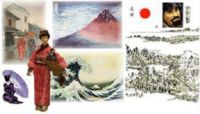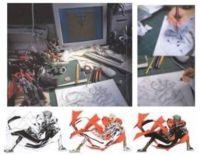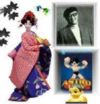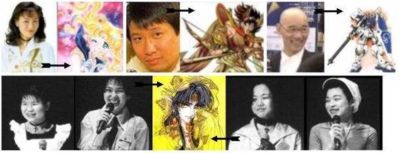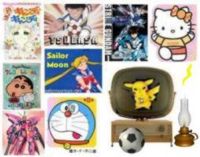Over 1 billion comics are published in Japan every year. But that intimidating figure would make sense when we know that the average Japanese reader finishes one page in less than 4 seconds, and that includes blinking. Those comic books contain what we call 'manga' [pronounced 'mahngah']. This word isn't an isolated, lonely, kinky orphan; it was born around 1800's through the utterance of a Japanese artist named Katsushika Hokusai (1760-1849), who merged the characters of 'in spite of oneself' and 'picture' . [If you forgot, let me remind you that the Japanese 'alphabet' consists of 'characters' instead of letters, and each has its own meaning if not combined with any of its 'colleagues'. So the characters still retain their 'individuality' even after forming the incorporation named 'manga': 'man' denotes an act or thing that you can't help but doing or making (BTW why does this remind me of something else?); while 'ga' means 'picture'.].
There was no street artist in the first 7 hundred years of the A.D., not in Japan anyway, but drawing is, as Katsushika said, something 'in spite of' (either he or a New York spraycan artist did). We know kids make little pictures on anything nearest when idle or bored in classes. So archeologists still found such fetuses of manga on temple ceilings and other unlikely places, guessed at as the result of what makes today's kids draw monsters on their History textbook. The drawings were mostly caricatural, and must have entertained the local spiders all through the two millennia, because they still exist even today as you read this. Such historic ceilings can be found easily by tourists if they look for olden days' capital cities like Nara and Osaka, and the Emperor's city Kyoto, that are infested by ancient Buddhist and Shinto temples, in which the manga pioneers had once unconsciously engraved their immortality. Each ancient spot has its own league of proto-mangaka -- this word means 'one who creates comics'. Click here for the period in Japanese history that gave birth to this proto-manga.
There is one immortal name among the olden day Japanese people who took religion as their job: the bishop Toba, reportedly to have been living between the year 1053 to 1140. As very sane and intelligent people always do, so did the Bishop: in his spare time, he made drawings that ridicule his own vocation. Toba's series of animals as priests and Buddhas and so forth are still around these days as invaluable artefacts. They have given him the unpleasure of having his name transformed into a term: Toba-e is what the Japanese dub early manga. This was also something 'in spite of', because modern scrutiny yielded some data that said Toba only created a few of the whole bulk of Toba-e in his time. Anyway, the creative bishop was lucky; imagine what would have become of him if he lived in Spain at the time of Isabella's Inquisition. Instead of being immortalised as a term to call funny pictures by, he could have suffered the fate of being remembered forever as a saint. But in Japanese Buddhism, even drawing priests being drunk and gambling, people in a phallic contest (sic.), a frog majestically posing as Buddha, and so on, was not considered heretic. This open-minded, worldly and cool system of belief of the time had a sense of humor that no counterpart of it did -- a system that also produced the 'Zenga' ['zen-gah'], Zen pictures -- i.e. the forepictures of those bulk of mostly empty pages with a few brush strokes here and there that look like something but intended to be something else and after reading the wordy explanation next to it then you slap your forehead and go back to golf. Zenga hasn't changed between the heyday of clergymen and now, although back then they used scrolls next to 100 feet each. Zen artists like Hakuin Ekaki (1685-1768) and Sengai Gibon (1750-1837) are among the ones cited today whenever we talk of manga. Unfortunately Zen was finally discovered by the LSD Generation of America and re-exported everywhere else since, including to Japan. Manga is, so far, safe from the same predicament, unless you count the best-selling books on manga which are mostly written by non-Japanese.
It goes without saying that the association of ukiyo-e with sexual pictures wasn't intentional; the term merely indicates the Buddhist concept of accepting life as it is -- 'ukiyo' means something like "you are utterly hopeless: you were born involuntarily and then you will die -- so get more anime DVD's"; affirmation of such things to ease the existential pain a little because you have no power to change the world anyway. Only one thing could save those on the brink of Nihilism: some good sense of humor. So such pictures were often given humorous shots. At the early days of ukiyo-e, it consisted of mainly charms that travellers could get from temples. But no matter what, the term and the association still stick together until approximately right now. Major search-engines would warn you that the 'family filter' must be turned off if you dare to ask them to seek ukiyo-e, and ask you if you are really of the age of doing financial mischief -- of which, of course, your 12 year-old kid answered in the affirmative, and then he used your credit card. Thus it is no wonder that in the course of time ukiyo-e begot what is usually dubbed 'hentai', i.e. erotic pictures, sic. -- there, humor is quite predictably accidental. The similar fate of negative association would in time befell manga, too, since there is also the thing called 'shunga' ['shoon-gah'], or erotic drawings that from the beginning were intended to elicit laughter. Yet the pioneering Japanese comic book was not erotic. The first known manga book (printed in monochrome) was founded in 1702 by a man named Õoka Shumboku -- actually the book was an album of cartoons with words here and there, sometimes even folktales, but with no distinct plot encompassing the whole stuff. The cartoons got instant craving from people of the time, and inherited the term 'Toba-e'. So far so maddening, right? And then came Katsushika Hokusai. His infant use of the word 'manga' implies impromptu sketching. The modern use came into being when the 20th-century started, but it wasn't yet an export item until late 1980's to 1990's. Like all things, manga would perhaps have never been made an entry in the world's common lexicon if it were not force-planted first in the U.S. of A. Around Katsushika's time came also several others who dabbled in caricatures, puzzle pics and 'portraits' of warriors -- all of which have been the roots of today's manga's visualization. Ukiyo-e artists Toshusai Sharaku, Utagawa Kuniyoshi, Tsukioka Yoshitoshi, Suzuki Harunobu, Utagawa Toyokumi, Kitagawa Umano, Kikugawa Eizan, Ikeda Eisen, Ando Hiroshige, Utagawa Kunisada, and so forth, all artistically flourished between 1700's and last century. Afterwards, you know manga has made it.
So, further distancing itself from the established Northern comic books, the Japanese counterparts could reach thousands of pages per title. No matter where and what you are, this is still awesome, isn't it? Especially if you work in recycling. However, if you think the market is over-saturated, that is a wishful thinking. In fact, since the end of last century, the market (even if excluding your credit card) is growing. And its segments are overlapping each other, like, adults read manga books for kids (the opposite is natural, so it isn't worth mentioning), women read men's, teenagers read anything. And so on. This is the logic of the answer to why all the billion manga books in Japan sell. And that is why I don't try to add more terms to enhance your headache -- actually the manga world divides readers into 'shonen', 'shoujo', etc., equivalent to 'manly', 'girly', and so forth -- but all these never matter in real world because your credit card is gender-blind and doesn't mind your age, neither do primal instincts. Later, some of the manga are taken into animation studios and retold in the form of movies, and this is what 'anime' ['ahneemay'] is.
Anime could come to us as TV series, whose running time is typically too short and with super-long commercial breaks and if compiled later in a DVD they are powerful enough to make you scream since each sequence must be started with the same credit title and opening song and all. It could also become a so to speak 'independent' story animated for animaniax and rentals (called Original Video Animation); that's what it means if you chance upon an ad saying 'OVA'. Or it could be made into a movie. And did I say 'or'? For tomes whose fans exceed the crowd of the Super Bowl, it is 'and'. That's the law of the marketplace. So you get heavy boxes of TV anime DVD's and OVA's and movies for more titles than necessary. Each with its own tailing knickknacks that they of course say you also must get to testify of your place in the fandom. The same process of torment suffered by your credit card as is outlined in the previous paragraphs then get repeated -- and the only change is the product here; now it is movie tickets and VCD's and DVD's and tapes and audio CD's and CD ROM's and game-consoles and toys and models and statues and stationery and so on. I guess by this time you would probably need a shrink.
Now a bit about how anime gets to wherever you are today. In the dusty yet not-so-long-ago time, when old cities began to get overweight and thus suburban areas started to be a new synonym for the term 'eyesore', the post-LSD generation of the Northern hemisphere imported anime from the Land of the Rising Sun at approximately the pace of a snail-mail package sent from Alabama to Tibet. The riotous 1970's has just received enlightenment in this field of concern -- the quicker-witted Americans in the industry started to stop calling non-human-non-nature-non-animal motion pictures 'cartoons' and have used the word 'animation'. Naturally the content of slim boxes of taped animation movies embarking there was then called 'Japanese animation', and for the convenience of those who tend to misspell anything more than three-lettered it was promptly squeezed into 'Japanimation', so no wonder that they still misspell it. Anyway, no derogatory wink was involved in the term 'Japanimation' -- it's just a matter of geoprofile for the product that has come in faster and in bulk during 1980's. The malicious intent is not there, if you really are so paranoid about such things; it is for instance in the term 'Japornimation', for which the Yoshiwara might have had an influence (i.e. modern sexually explicit and repulsively bloody anime movies). Meanwhile, in 1990's someone (probably the same person who snail-mailed from Alabama to Tibet) informed the Northerners that the Japanese themselves have always called the thing 'anime'. From then on 'anime' often replaces 'Japanimation' in the lexicon, but it didn't blast the old word out of circulation -- usually attached to the 'Old School' of diehard, seasoned, loyal and zealous anime fans ('otaku') among the Americans, it is still valid to use 'Japanimation' today in any case of generally useless elaboration such as this, plus the term 'anime' is seen as too wide to refer to just the characteristic Japanese product -- 'anime' could mean the entire baggage this planet must carry in the form of every kind of animation, including Beavis & Butthead. Today, the USA has been one significant even if struggling spot of anime-consumers. Made available via Comcast/RCN, Cablevision and Time Warner, the Anime Network is the first cable channel catering to this genre, albeit still centers on around New York, New Jersey, Los Angeles, Washington, D.C., Chicago, and a thin list of smaller cities while leaving the likes of Missourian towns intact. The Japanese anime magazine Newtype has been having its American cousin since 2004. These make some people hopeful of the development of at least consumers if not creators of anime in North America. We shall see where it would sway, while today the American fans usually still get their DVD's jet-lagged and their anime history hundreds of pages late. As a matter of course not all anime movies are worth your time even if you got too much to waste. And, like two thousand years of civilization has taught us, there is no way you can tell which one is what except by tapping sources like anime sites and magazines. The visually triumphant titles might roll along an awkward cliche, while the best storylines only get themselves strangled by visual inadequacy. Worse, there have been good anime movies with some good plot and animation alike, which flopped just because of their titles. Sometimes a perfectly watchable series has to endure the 'funny' Japanese habit of using languages, thereby if you know nothing whatever of the series and only bump into its name somewhere you would inexplicably dismiss is as silly or stupid or absurd. This come from clueless translation and from within the creative process itself. Some examples in alphabetical order, regardless of the artistic and literary qualities therein: Assemble Insert (1989), Bubblegum Crisis (1987), Chalk-colored People (1988), Cool Cool Bye (1986), Devilman Lady (2001), DNA Sights 999.9 (1997), Don! Brutal Water Margin (1992), Dragon Half (1993), Earth Girl Arjuna (2001), Eat-man (1997), Emblem Take Two (1993), Geobreeders (1998), Getter Robo (1974), Grappler Baki (1994), High Step Jun (1985), Idol Fight Sweetypie II (1996), Leave It to Scrappers (1994), Let's Nupunupu (1998), Littl' Bits (1980), Machine Robo (1986), Melty Lancer (1999), Peach-colored Sisters (1998), Plastic Little (1994), RUN=DIM (2001), Slippy Dandy (1987), Teacher Tank Engine (1996), Trouble Chocolate (1999), Weather Permitting (1984), Zero Enders (2001). And how could I ever forget the title that reads I My! Me! Strawberry after all those? Not to mention Please Twins, E's Otherwise, and Pretear -- no matter what that is supposed to mean. Some of the titles I snatched as examples here really tell what is inside the discs, but a few are lightyears away from what they actually offer -- in the latter's case, too bad. Yet it will keep going on like that. No Shakespeare is needed anywhere in the world, let alone in Japanimation, but I wish they would pay a bit more attention to their way with words. They cause migraines, although touchingly nobody at all has ever said anything about it in writing, since all minus one manga and anime fans -- including anime reviewers and anime sites' webmasters and anime magazines' editors -- take it as mandatory to just accept whichever product as they are.
I grew up being taught English by the Walt Disney Co. Japanimation came very late to my part of the globe, i.e. shortly before the last decade of 20th-century began -- this is kind of remarkable because we are just a blink away (no Atlantic ocean between us, you see). Among the first manga series (and afterwards its animated version) that created huge waves of consumers' craze in Indonesia was Candy Candy (the anime was released in 1978, director Serikawa Yugo, designer Igarashi Yumiko, animators Morishita Keisuke and Tomizawa Kazuo; based on the manga by Mizuki Kyoko and Igarashi Yumiko who later got themselves entangled in an unpretty feud over copyrights). Candymania was the first notable fan-based livelihood for many. However, Indonesian kids had already developed some craftily- induced passion for Sanrio merchandise like Hello Kitty -- long before they knew the anime; in this case admittedly which was to boost the sale of which was indeed rather blurry. Hello Kitty was animated in 1989 by a pack of directors.
Here in Indonesia anime magazines have loudly rose and noiselessly faded away. The one that is somewhat still at large calls itself Animonster, kept alive by something smacks of a crusading ethos of a few young West Javanese anime reviewers. West and East Java seem to host the best, even if shaky, soil for anime in this archipelago, while the rest of the country slumbers although virtually all TV stations have been broadcasting anime series. It is still hard to this very day to get original anime DVD's even in the capital city Jakarta. Only translated manga books seem to grow somehow, toy shops sell a tiny chunk of both original and pirated anime-based merchandise, and VCD's of downloaded anime features and fan-subtitled copies are somewhere down there in the black market. To make a purchase means violating the law, so you'd feel like starring in a typical second-rate movie of drug-dealing when trying to get the goods from the anime secret traders whose existence is only given out by ads consisting of nothing but frequently-changed cellphone numbers and imposing names of their 'stores'. But stuff like that is not immediately synonymous with sin to generous beholders. Japanese comic books and animation movies could never have been what they are today if not for the fans. Thousands of individuals have cranked up their sources to produce manga and/or anime web sites in just a few years; there are hundreds of active mailing lists, chat rooms, forums, clubs, and so on that cater to this particular subject. Serialization in itself has the dormant power to construct fan bases via the thing that you could probably call 'addictive' element it contains in every release. This might sound like an X-Files subplot, but the ones who conspire here are the hundreds and thousands and millions of fans. They keep the art (some opt for the term 'industry') alive that way, forming a self-sustained subculture. This is a fantastic realm of daydreamers. They hold community meetings on a regular basis. They have workshops for the thing commonly known as 'fan art'. This term means authentic drawings of the already existing manga and anime characters, according to the fans' own taste and -- of course -- skill; new episodes entirely independent from the original series; new storylines, new plots, spinoffs that are unthinkable by the original producers; each of which can be as long as a novel. They also have their own magazines offline, which means they are willing to go to that extent of real management. Such magazines don't only dish out manga and anime, but also feature Japanese culture and language. That learning Japanese has come close to a fashionable pastime in Indonesia, for instance, perhaps isn't just fueled by the opportunistic aim at finance and futuristic industrial goals, but manga and anime might have also had their share.
|
|
| OUTBOUND LINKS |
Anime image galleries - Anime academy - Anime synopsis - Anime pop culture - Anime history in English - Anime history in Italian - Anime history in Russian - Japanese rare prints and drawings - History of Japanese samurai & the feudal system - Just one example of a fan site with personal review - Matsumoto Leiji database - Ragnarök - Takeuchi Naoko - Kurumada Masami - Gundam - CLAMP - Best Asian Movies - My Species of Japanese Actors - All & Everything about Japanese Culture |

